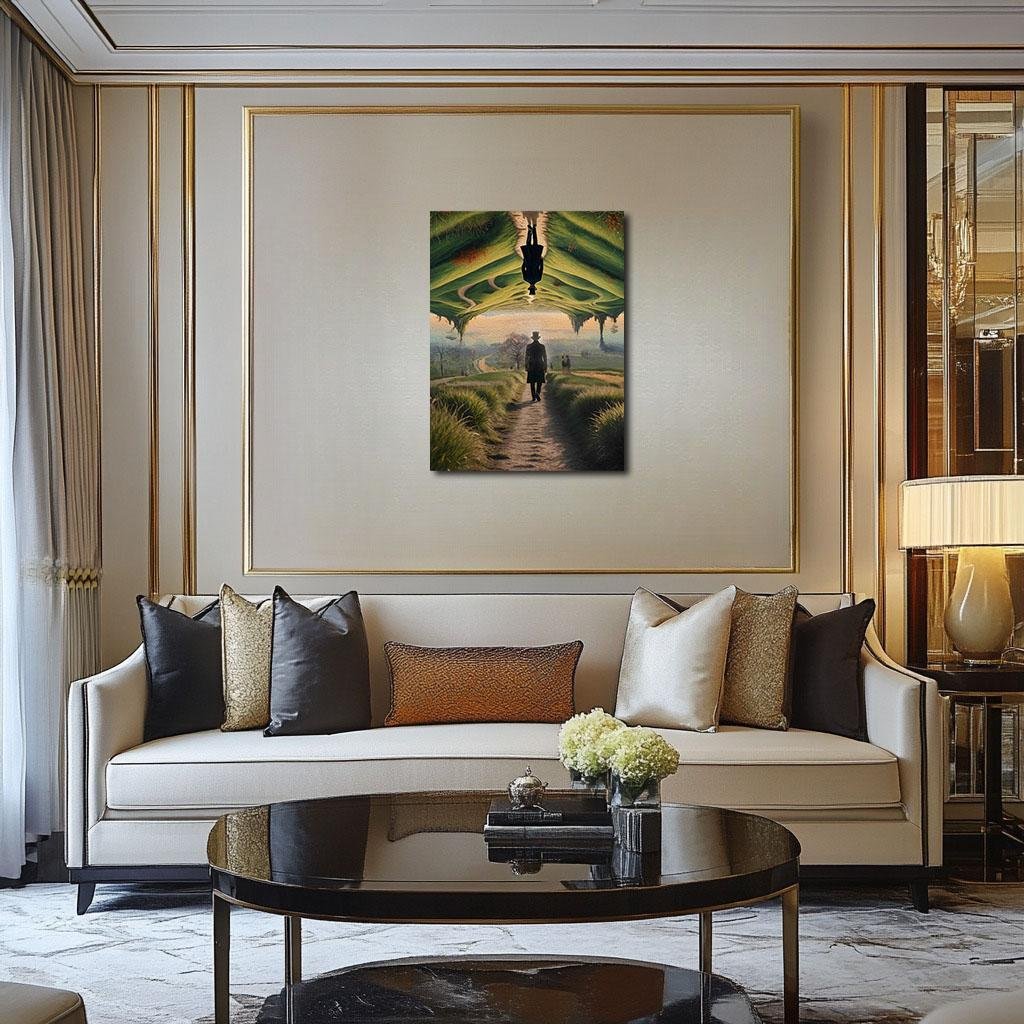The Folded Walk: Hyde Park in the Realm of Reversal
The Folded Walk: Hyde Park in the Realm of Reversal transforms Monet’s 1870s vision into a surreal meditation on mirrored identity and recursive memory. A solitary figure walks a path through Hyde Park, beneath an inverted landscape where his twin steps silently above. Between golden haze and cool reflection, the piece explores time, selfhood, and the quiet tension of parallel lives converging in a single unfolding step.
Please see Below for Details…
Hotline Order:
Mon - Fri: 07AM - 06PM
404-872-4663
Claude Monet’s Hyde Park , painted in the 1870s during his brief visit to London, captures a city in stillness—fog-laced paths, morning light diffused through trees, and figures moving quietly along the winding park lanes. In its original form, the piece speaks to solitude within movement, a contemplative gaze upon the public and the private merging in open air. In this surreal reinterpretation, titled The Folded Walk: Hyde Park in the Realm of Reversal , the scene unravels and reweaves itself in a world where direction loses meaning, gravity bends to metaphor, and the path becomes not just one of ground and shadow—but of mirrored existence.
At the heart of this composition, a lone figure walks away from the viewer. Clad in black and topped with a tall hat, he follows a curved dirt path lined with tall grasses, his gait unhurried, posture composed. This figure—central and deliberate—becomes the axis of the entire work. He is both a participant and a symbol, and as the path stretches before him into the distance, the boundaries of his reality dissolve. This is not just a man in a park. This is the self moving through a memory it does not fully control.
Above him, the sky is no longer sky—it is land, inverted. An uncanny mirrored world folds downward, reflecting not clouds or light, but another path, another figure—an upside-down twin, suspended from the very soil that the man below walks upon. This inversion is not abrupt. It is seamless, natural, as if the landscape were breathing inward and outward at once. The mirrored path winds as the lower one does, but subtly different, more serpentine, more isolated, as though it had been shaped by thought rather than footstep.
The trees of Hyde Park remain in both realms. In the lower world, they are dispersed across the open countryside, delicate with spring or autumnal edge. In the inverted realm above, they cling upside-down, roots unseen, their branches echoing brushstrokes of both elegance and disquiet. They float, yet feel grounded in emotional weight. Some tilt sideways, as if bending toward the figure below or reaching to reclaim him. Their presence is both serene and watching, as if they too are caught between the worlds they inhabit.
Throughout the composition, light functions not as illumination but as transition. A golden wash suffuses the lower scene, stretching across the distant hills and softening the haze that settles above the trees. But as the eye moves upward, this light becomes cool, more reserved. It moves not toward the viewer but away—pulling perception inward, as if the mirrored realm resists being fully seen. The difference in lighting creates a soft tension, as though two emotions were passing each other in silence.
There are other figures scattered along the ground path—walking in pairs, seated on distant benches, drifting across the parkland like half-formed recollections. They move freely, unaware. Their faces are turned, features obscured. But above, in the inverted world, only one figure stands—directly aligned with the walker below, poised mid-air, frozen like a thought suspended before speech. His presence is heavier, even in inversion, casting no shadow but radiating consequence.
The surrealism of this piece is not simply a gesture of inversion—it is a structural reorientation of experience. The park is no longer a space to wander. It is a passage to recognize. The path becomes a question of identity, reflection, and fate. The two versions of the man are not opposites. They are coexisting choices, doubled selves. One walks forward into the unfolding world, the other retreats backward, as if returning from a moment that never happened.
As the artist, I approached this reinterpretation as a meditation on decision, memory, and the idea of the mirrored self. Monet’s Hyde Park offered a place where observation was quiet, nearly anonymous. In The Folded Walk , that quiet is transformed into a mirror—where every step is answered by its opposite, every path has its twin above, and every motion carries the echo of its unmade reflection. The landscape becomes a psychological architecture, shaped not by hills and trees, but by internal space, layered with longing and the questions that follow us in silence.
There is no sky in this Hyde Park. There is no end to the path. Only the fold, the gaze, and the slow unfolding of the self within the mirrored fields of becoming.
Add your review
Your email address will not be published. Required fields are marked *
Please login to write review!
Looks like there are no reviews yet.








